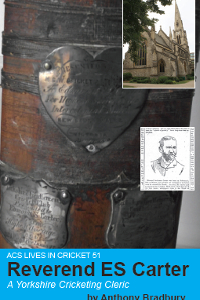Reverend ES Carter: A Yorkshire Cricketing Cleric
Martin Chandler |Published: 2018
Pages: 120
Author: Bradbury, Anthony
Publisher: ACS
Rating: 3 stars

The now long running ACS Lives in Cricket series has contained some excellent biographies, always of those who have not previously been the subject of such books, and on a number of occasions on men whose achievements on the field have been relatively modest. That was always to be expected given the aims of the series but I have to say that, being a self-confessed cricket tragic, I did not initially expect to find any books in the series about men whose names, however much I wracked my brain, I simply did not recognise.
In fact however there have been two such. The first, way back in 2009 and the eleventh in the series, was a Welshman, CP Lewis, and then almost ten years later, and on to book 51, the Reverend ES Carter became the second unfamiliar name. At least in both cases the writers were known quantities. In the case of Lewis Bob Harragan and Andrew Hignell, and with Carter Anthony Bradbury, a now retired Judge and former solicitor who has previously contributed an excellent life of Frank Mitchell to the Lives in Cricket series. More recently he gave us an account of the interesting life of Frank Gillingham.
Perhaps unsurprisingly the two men, Lewis and Carter, are from the same era, having been born in 1853 and 1847 respectively, and neither had substantial First Class careers. For Lewis there were five appearances, all for Oxford University. As for Carter he appeared in a total of 29 First Class matches over a 17 year period, 14 for Yorkshire, a dozen for Oxford and one each for the Gentlemen of the North, the famous wandering club I Zingari, and one in Australia, where he helped Victoria beat New South Wales in 1869. He played a match winning role as well, top scoring in both innings with 16 and 63, the latter being the higher of his two First Class half centuries.
Carter was one of eleven children of the Reverend William Carter. There was clearly some money in the family and Carter was able to play his cricket as an amateur and follow the same career as his father. After his time at Oxford ill health took him to Australia, where he clearly made a good recovery, and he was then briefly in London where he was one of the early stalwarts of Ealing Cricket Club. After a few years in the capital he returned to Yorkshire where, most notably, he was responsible for introducing Lord Hawke to the county.
So is Carter’s an interesting story? The best answer to that is probably ‘not particularly so on its own’, although as a slice of social history and an example of a middle class life in the times in which Carter lived it is. Like all such projects therefore it depends how well the story is told, and that is where author Bradbury does rather well.
A legal training does not, speaking from experience, equip a storyteller very well on its own, although it is an often overlooked part of conducting a case. It took me many years to work out that judges are human beings, and that whilst they all take their duties seriously, as you would expect, you will inevitably do rather better if, in addition to presenting your case as well as you can, you can make it an interesting one as well. Writing is clearly a skill which Bradbury’s legal career prepared him for, and he has produced an interesting book about this little known but in his own way important Yorkshire cricketer.






Leave a comment